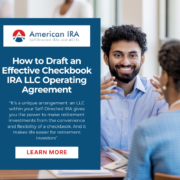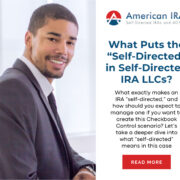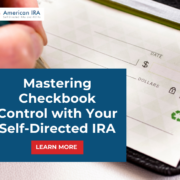How to Use Checkbook Control in a Self-Directed IRA
Imagine this scenario. You’re about to make an investment in a small piece of real estate—an asset that could really set you on the path to building wealth. You needed quick funds, so you’re able to cut a check. Another party finds it admirable that you were able to move funds that quickly. “Not only that,” you say. “But within a retirement account.” It sounds impossible, but that’s what Checkbook Control in a Self-Directed IRA can mean: the ability to use tax-protected retirement funds to invest in critical assets like real estate. How does it work? Let’s explain.
Why a Checkbook Control IRA in the First Place?
There are lots of reasons why the Checkbook Control IRA is the investment vehicle of choice for investing retirement funds. But let’s look at some of the most pressing.
- Alternative investments: Since 2002, the Checkbook Control IRA has steadily grown in popularity. Why? Partially because it’s such an easy way to place real estate purchases alongside other alternative investments. With a Checkbook IRA, you’re not just limited to stocks and mutual funds; you can explore tax liens, precious metals, trust deeds, private company shares, and much more. You can explore all sorts of lucrative opportunities this way—while still investing in an intuitive way.
- Checkbook control within retirement funds: A Checkbook Control IRA is manager-managed, meaning you take the reins as the LLC manager. This structure gives you full control over your investments. You can then place funds into any asset permissible under IRS regulations. When you’re ready to make a purchase, it’s as simple as writing a check from the LLC checking account.
- Benefits of using a Checkbook Control IRA: Using a Checkbook Control IRA offers several advantages. First, the liability protection that comes with an LLC structure shields your personal assets from any potential risks associated with your investments. Second, investors can execute transactions quickly and confidently, as most realtors, title companies, and investment firms are accustomed to dealing with LLCs. Third, you’ll benefit from lower fees, since you’ll be handling paperwork, due diligence, and other necessary tasks, reducing reliance on third parties.
Put it all together, and clearly Checkbook Control IRAs are a great way to add more flexibility to how you handle retirement investments. But it helps to know a little bit more before you dip your toes in the water.
How Do Checkbook Control IRAs Work?
Once you fund your Checkbook Control IRA, you can start making alternative investment purchases by writing checks directly from your LLC’s checking account. This approach grants you unparalleled flexibility to invest your retirement funds while still reaping the tax benefits offered by Traditional and Roth IRAs.
Before diving into your Checkbook IRA, you’ll want to be aware of the IRS regulations that govern Self-Directed IRAs. While Checkbook Control provides all sorts of freedom and flexibility, adhering to these rules is critical if you’re going to maintain your tax-advantaged status. Our recommendation? Engage with a knowledgeable custodian or advisor to navigate the complexities of self-directed investing and ensure compliance.
Leveraging Checkbook Control in a Self-Directed IRA empowers you. In simple terms, it means you can take charge of your retirement investments. By providing direct access to your funds and the ability to invest in a wide array of assets, you can cultivate a robust portfolio that aligns with your financial goals.
But it never hurts to get started off on the right foot. That’s why we at American IRA recommend checking out all you can when it comes to research—and then getting in touch with a Self-Directed IRA administration firm you can trust. Interested in learning more about Self-Directed IRAs? Contact American IRA, LLC at 866-7500-IRA (472) for a free consultation. Download our free guides or visit us online at www.AmericanIRA.com.











